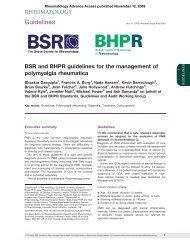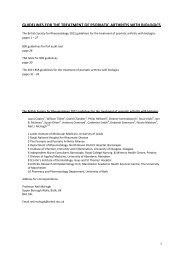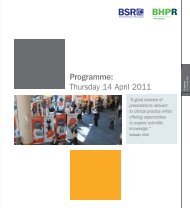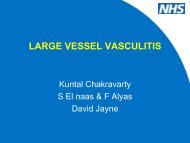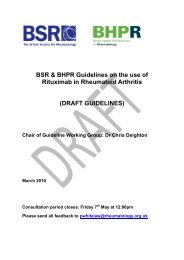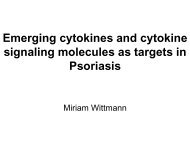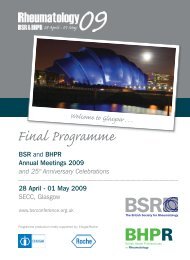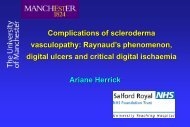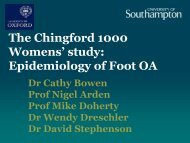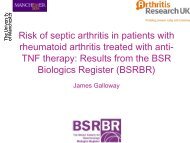BSRBR|Newsletter - The British Society for Rheumatology
BSRBR|Newsletter - The British Society for Rheumatology
BSRBR|Newsletter - The British Society for Rheumatology
Create successful ePaper yourself
Turn your PDF publications into a flip-book with our unique Google optimized e-Paper software.
www.rheumatology.org.uk<br />
(see Table). <strong>The</strong> median disease duration remained high (9 years in 2007) although<br />
the proportion of patient with disease 5.1 following failure of ≥2<br />
DMARDs including methotrexate) (n=766) followed <strong>for</strong> 6 months. Patients completed<br />
the EQ-5D, SF-36 and HAQ at baseline and at a 6-month follow-up assessment.<br />
Predicted EQ-5D scores were estimated using the HAQ (1) or the SF-36 (2) . <strong>The</strong> mean<br />
difference between predicted and observed EQ-5D scores at baseline and change<br />
during the study was tested using the t-test.<br />
Results: <strong>The</strong> patients recruited to this study had a mean age of 58, disease duration<br />
of 12 years and predominance of females (Table). HAQ and SF-36 physical<br />
component summary score (PCS) indicated considerable physical disability, and the<br />
patients had low HRQoL scores. Predicted EQ-5D scores were higher than observed<br />
scores at baseline, although this was only significant where estimated using the HAQ<br />
(p=0.007). Over 6 months of follow-up patients improved in physical function and<br />
HRQoL, with change exceeding the minimum important difference (MID) <strong>for</strong> the HAQ<br />
(MID 0.20), EQ-5D (MID 0.05-0.07), PCS (MID 2-3) and mental component<br />
summary scores (MCS) (MID 3). Change in predicted EQ-5D scores (both methods)<br />
also exceeded the MID, and corresponded well with observed EQ-5D scores. Although<br />
change in EQ-5D appeared to be underestimated when predicted from HAQ scores<br />
and overestimated when predicted from the SF-36, neither were significantly different.<br />
Age Mean (SD) 58.3 (12.2)<br />
Gender N (%) 583 (76%)<br />
Disease duration Mean (SD) 11.8 (10.9)<br />
Baseline<br />
6-month change<br />
n=766 n=699<br />
HAQ Mean (SD) 1.72 (0.71) -0.22 (0.54)<br />
SF-36 PCS Mean (SD) 20.4 (10.8) 4.6 (10.3)<br />
SF-36 MCS Mean (SD) 45.0 (11.3) 3.0 (11.4)<br />
EQ-5D Observed 0.40 (0.33) 0.08 (0.32)<br />
Predicted (using HAQ) 0.44 (0.26) 0.07 (0.24)<br />
Difference, mean (95% CI) 0.04 (0.01, 0.07) -0.02 (-0.05, 0.01)<br />
Observed 0.40 (0.33) 0.08 (0.32)<br />
Predicted (using SF-36) 0.42 (0.25) 0.10 (0.23)<br />
Difference, mean (95% CI) 0.02 (-0.01, 0.05) 0.02 (-0.01, 0.05)<br />
Conclusions: Predicted EQ-5D scores from the HAQ and the SF-36 were reasonable<br />
estimates of mean baseline and change EQ-5D scores in the RA patients with severe<br />
disease. However small differences in response to change could have implications in<br />
assessing the cost-effectiveness of treatments; underestimation of change (e.g.<br />
EQ-5D estimated from the HAQ) may lead to underestimation of cost-effectiveness,<br />
whilst over-estimation (e.g. SF-36 to EQ-5D) may overestimate cost-effectiveness.<br />
For this reason, estimating EQ-5D scores may be valid where no alternative exists or<br />
<strong>for</strong> sensitivity analyses, however we recommend that prospective studies should<br />
include at least one measure of HRQoL which allows the estimation of utilities.<br />
References (1) Bansback N, Marra C, et al. Arthritis Rheum 2007; 57:963-71. (2)<br />
Ara R & Brazier J. Value in Health 2008; 1131-43<br />
THE INFLUENCE OF ANTI-TNF THERAPY UPON CANCER INCIDENCE IN PATIENTS<br />
WITH RHEUMATOID ARTHRITIS (RA) WHO HAVE HAD PRIOR MALIGNANCY:<br />
RESULTS FROM THE BSRBR<br />
WG Dixon, KD Watson, M Lunt, BSRBR Control Centre Consortium, KL Hyrich, DPM<br />
Symmons, on behalf of the BSR Biologics Register.<br />
Purpose: Anti-TNF therapy is rarely prescribed to patients with a history of prior<br />
malignancy following theoretical safety concerns, clinical trial exclusion criteria and<br />
national guidelines. Thus, there is currently no published evidence regarding the safety<br />
of anti-TNF therapy in patients with prior malignancy. Our aim was to explore the<br />
influence of anti-TNF therapy upon the incidence of cancer in patients with prior<br />
malignancy, using data from a large national register.<br />
Methods: 10735 consecutive anti-TNF treated patients with RA registered with the<br />
BSRBR were followed prospectively. <strong>The</strong>y were compared to 3236 patients with active<br />
RA on disease modifying anti-rheumatic drugs (DMARD). Patients with a malignancy<br />
prior to registration were identified by record linkage with the UK Office <strong>for</strong> National<br />
Statistics (ONS). Further analysis was restricted to these patients. Incident<br />
malignancies up to 30/9/07 were identified from consultant and patient<br />
questionnaires and ONS. Local recurrence and metastases were included as incident<br />
cancers. Carcinoma-in-situ and non-melanoma skin cancers were excluded from both<br />
prior and incident malignancies. Patients contributed follow-up time until 30/9/07 or<br />
death, whichever came first. An individual patient could contribute >1 incident<br />
malignancy. Incidence rate ratios (IRR) were calculated comparing the anti-TNF to<br />
the DMARD-treated cohorts. Results: 177 (1.6%) anti-TNF and 118 (3.6%)<br />
DMARD-treated patients had a history of prior malignancy. Registration occurred within<br />
10 years of the prior malignancy in 75 (42%) of the anti-TNF and 71 (60%) of the<br />
DMARD treated patients. After median follow-up times of 3.06 and 1.93 years in the<br />
anti-TNF and DMARD-treated cohorts, there were 13 incident cancers in 11/177 (6%)<br />
anti-TNF treated patients compared to 10 cancers in 10/118 (8%) DMARD-treated<br />
patients. <strong>The</strong> crude rate of incident cancers was lower in the anti-TNF cohort (25.3<br />
events / 1000 person years (pyrs) (95% CI 13.4, 43.2)) compared to the DMARD<br />
cohort (41.9 / 1000 pyrs (20.1, 77.1)). <strong>The</strong> age- and sex-adjusted IRR <strong>for</strong> anti-TNF vs<br />
DMARD-treated patients with prior malignancy was 0.53 (0.22-1.26). 17 patients in<br />
the anti-TNF cohort had prior melanomas compared to 10 in the DMARD cohort. Of<br />
concern, 3/11 anti-TNF patients with prior then incident malignancy had prior<br />
melanomas. <strong>The</strong> time from melanoma to starting anti-TNF therapy was 33%) of patients with ankylosing spondylitis (AS) need to give up work<br />
be<strong>for</strong>e normal retirement. <strong>The</strong> beneficial clinical effects of anti-TNF therapy seen in<br />
patients with AS hopefully will lead to less work disability in the future.<br />
Aim: To describe working status at start of anti-TNF treatment and at three years after<br />
starting anti-TNF therapy.<br />
Methods. 229 consecutive patients with AS (aged





